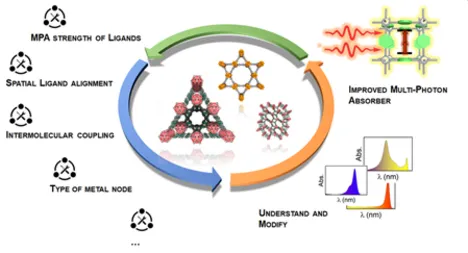Multiphoton Absorption in Metal-Organic Frameworks
multiphoton absorption • chromophore design • instrument development

S. Weishäupl,(a) M. Aust,(a) A. Pöthig,(a) J. Hauer,(b) R. A. Fischer(a)
(a) Chair of Inorganic and Metal-Organic Chemistry, Faculty of Chemistry, Technical University of Munich, Lichtenbergstr. 4, 85748 Garching
(b) Chair of Dynamic Spectroscopy, Faculty of Chemistry, Technical University of Munich, Lichtenbergstr. 4, 85748 Garching
The project aims at the development of non-linear optically active coordination frameworks. In particular, we intend to design, synthesize and investigate coordination polymers (CPs) and metal organic frameworks (MOFs) with increased two-photon absorption (TPA) cross sections. In this context, CPs and MOFs provide a unique structural and chemical basis for a targeted approach to functional materials. Our approach is to incorporate MPA-active molecular chromophores[1] as ligands in crystalline coordination networks. By comparing the TPA spectrum of the ligands in solution and in the CP, we can pinpoint – and later utilize – the physical mechanism behind increased TPA.[2,3] Herein, we present first results concerning the synthesis of new linker chromophores, their incorporation into coordination network materials and first results on a novel spectroscopic setup for the facile and reliable collection of two photon absorption spectra of MPA active solvated ligands and materials.
References
(1) S. J. Weishäupl, D. C. Mayer, E. Thryhaug, J. Hauer, A. Pöthig, R. A. Fischer, Dyes Pigm. 2020, (in press); https://doi.org/10.1016/j.dyepig.2020.109012
(2) Mayer, D. C., Zareba, J. K.; Raudschl-Sieber, G.; Pöthig, A.; Choluj, M.; Zaleśny, R.; Samoć, M.; Fischer, R. A. Chem. Mater. 2020, 46, 5730-5770
(3) Mayer, D. C.; Manzi, A.; Medishetty, R.; Winkler, B.; Schneider, C.; Kieslich, G.; Pöthig, A.; Feldmann, J.; Fischer, R. A. J. Am. Chem. Soc. 2019, 141 (29), 11594-1160
Interested in finding out more? Click here to learn more about this overarching COORNETs team and project.